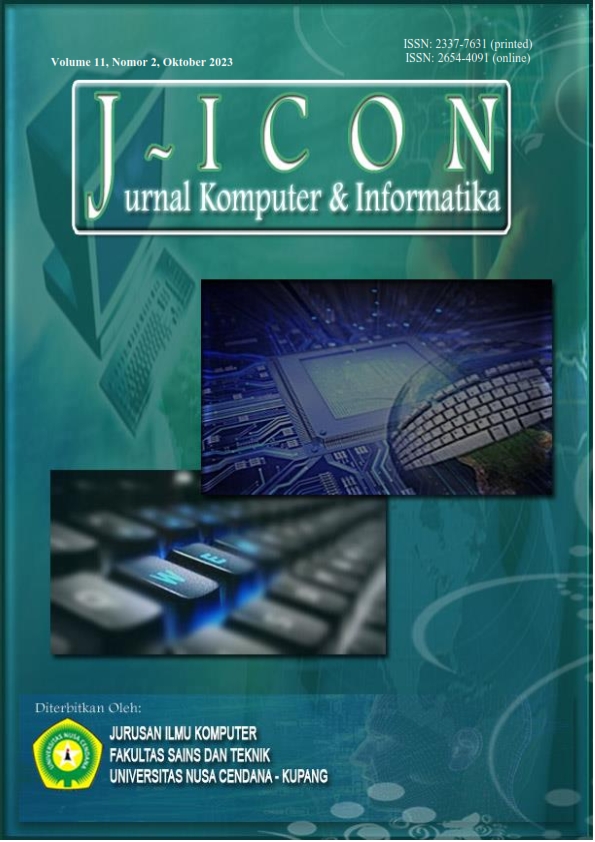IMPLEMENTATION OF THE K-MEANS ALGORITHM FOR CUSTOMER SEGMENTATION AT PT. BINTANG MULTI SARANA TUGUMULYO BRANCH
Abstract
One of a company's most important assets is its customers. Companies use various methods to retain customers by implementing various strategies, such as PT Bintang Multi Sarana which uses various methods to establish good relationships with customers, such as holding promos and discounts. Companies offer promotional items or discounts by contacting customers by telephone one by one or offering them directly when the customer has finished purchasing the previous item. Offering discounts and promos to all customers is less efficient because it costs a lot of operational costs and time. Therefore, customers at PT Bintang Multi Sarana need to be grouped first to make it easier for the company to determine appropriate services. Apart from that, sales transaction data at PT Bintang Multi Sarana is only processed into monthly reports. In fact, if processed properly, sales transaction data can be used to help determine strategies for retaining customers. The aim of this research is to segment customers to determine customer characteristics. One solution to this problem is to process sales transaction data by utilizing the role of data mining with clustering techniques using the k-means algorithm. The k-means algorithm is a distance-based algorithm that divides data into separate clusters. Based on calculations using k-means, customers are clustered into 3 groups, namely cluster 1 with 742 customers, cluster 2 with 795 customers and cluster 3 with 223 customers. From the results of the customer segmentation analysis, the results show that cluster 1 is a silver segment customer, cluster 2 is a gold segment customer, and cluster 3 is a platinum segment customer. The marketing strategy for the silver segment is by providing price discounts, promotions and advertising on social media, for the gold segment services are provided in the form of reward points or special discounts, while for the platinum segment, this is the provision of attractive prizes or exclusive access to certain products.
Downloads
References
N. R. Syarif and Windarto, “Implementasi Algoritma Fuzzy C-means dan Metode Recency Frequency Monetary (RFM) pada Aplikasi Data Mining untuk Pengelompokan Pelanggan,” Sebatik, vol. Vol.22, no, pp. 88–94, 2018. [Online]. Available: https://jurnal.wicida.ac.id/index.php/sebatik/article/view/313.
A. A. D. Sulistyawati and M. Sadikin, “Penerapan Algoritma K-Medoids untuk Menentukan Segmentasi Pelanggan,” Sistemasi, vol. 10, no. 3, p. 516, 2021, doi: 10.32520/stmsi.v10i3.1332.
B. E. I. S. dan A. E. P. Adiana, “Analisis Segmentasi Pelanggan Menggunakan Kombinasi RFM Model dan Teknik Clustering,” JUTEI (Jurnal Terap. Teknol. Informasi), vol. Volume.2 N, pp. 23–32, 2018, doi: 10.21460/jutei.2018.21.76.
M. H. Siregar, “Data Mining Klasterisasi Penjualan Alat-Alat Bangunan Menggunakan Metode K-Means (Studi Kasus Di Toko Adi Bangunan),” J. Teknol. Dan Open Source, vol. 1, no. 2, pp. 83–91, 2018, doi: 10.36378/jtos.v1i2.24.
Arwin, Buku Ajar Pengantar Ekonomi Mikro. Cendikia Publisher, 2020.
Rizky and Rosalina Noor, “Pengaruh Harga, Pendapatan, dan Halal Awareness Terhadap Keputusan Pembelian Produk Kosmetik Impor Pada Konsumen Pengguna E-commerce Sociolla (Studi Pada Mahasiswa di Universitas Brawijaya),” J. Ilm. Fak. Ekon. dan Bisnis, pp. 1–14, 2020. [Online]. Available: https://jimfeb.ub.ac.id/index.php/jimfeb/article/view/7036.
E. Listiana and M. A. Muslim, “Penerapan Adaboost untuk Klasifikasi Support Vector Machine guna meningkatkan Akurasi pada Diagnosa Chronic Kidney Disease,” Pros. SNATIF, no. 2015, pp. 875–881, 2017. [Online]. Available: https://jurnal.umk.ac.id/index.php/SNA/article/view/1463.
D. T. Larose and C. D. Larose, Data Mining and Predictive Analytics, Second Edi. Canada: John Wiley & Sons, Inc, 2015.
A. M. dan A. P. Siregar, Data Mining Pengolahan Data Menjadi Informasi dengan RapidMiner. Surakarta: CV Kekata Group, 2017.
W. Lestari, “Clustering Data Mahasiswa Menggunakan Algoritma K-Means Untuk Menunjang Strategi Promosi (Studi Kasus : STMIK Bina Bangsa Kendari),” Simkom, vol. 4, no. 2, pp. 35–48, 2019, doi: 10.51717/simkom.v4i2.37.
F. Astuti Hermawati, Data mining. Yogyakarta: Andi, 2013.
A. Wanto dkk, Biometrika: Teknologi Identifikasi. Yayasan Kita Menulis, 2020.
Suyanto, Data Mining untuk Klasifikasi dan Klasterisasi. Bandung: Informatika Bandung, 2017.
D. Fatihudin dan A. Firmansyah, Pemasaran Jasa (Strategi, Mengukur Kepuasan Dan Loyalitas Pelanggan). Yogyakarta: Deepublish, 2019.
Candrianto, Kepuasan Pelanggan Suatu Pengantar, I. Malang: Literasi Nusantara, 2021.
J. P. Nugraha dkk, Teori Perilaku Konsumen, 1st ed. Pekalongan: Nasya Expanding Management, 2021.
D. Z. Basil, G. Diaz-Meneses, and M. D. Basil, Correction to: Social Marketing in Action. 2019. doi: 10.1007/978-3-030-13020-6_30.
D. T. Larose and C. D. Larose, Discovering Knowledge in Data An Introduction to Data Mining, Second. United States of America, 2014.
U. Suharsaputra, Metode Penelitian Kuantitatif, kualitatif, dan Tindakan, Ketiga. Bandung: PT Refika Aditama, 2018.
I. dan H. M. Santoso, Metodologi Penelitian Kuantitatif. Indigo Media, 2021.
S. dan M. A. S. Siyoto, Dasar Metodologi Penelitian. Yogyakarta: Literasi Media Publishing, 2015.
Copyright (c) 2023 Herlinda Mawarni, Gusmelia Testiana, Muhammad Leandry Dalafranka

This work is licensed under a Creative Commons Attribution 4.0 International License.
The author submitting the manuscript must understand and agree that if accepted for publication, authors retain copyright and grant the journal right of first publication with the work simultaneously licensed under a Creative Commons Attribution (CC-BY) 4.0 License that allows others to share the work with an acknowledgment of the work’s authorship and initial publication in this journal.
 Herlinda Mawarni(1*)
Herlinda Mawarni(1*)




